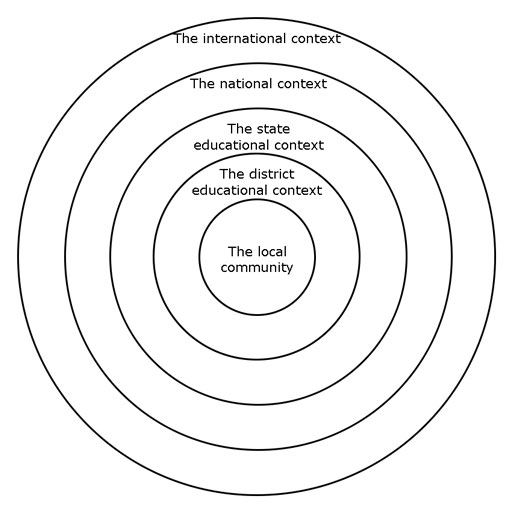3 Developing a vision for your school
A school vision must reflect the unique context of each school. But it cannot exist in isolation; it must also reflect the wider factors and influences shown in Figure 3.
Figure 3 The wider contexts that must influence your vision.
National and state contexts are set by the NCF 2005 and the RtE 2009. Your task is to develop a vision for your school that enables you to fulfil these expectations within your individual context.
Case Study 1: Mrs Chadha decides on a school vision
Mrs Chadha was the principal of a large girls’ school. She went on a course where she realised the need for a school vison. During the course she was made aware of different visions, talked to a number of school leaders about their visions and was impressed by many of the ideas. She participated in discussions and became clear about the vision for her school.
She returned with enthusiasm and could not wait to tell the staff, parents and community about the new direction for her school. She realised that her school was doing a good job for its more able students, but it was not including all students equally and that many students who came with limited literacy skills were unhappy in school and not doing well. She thought that the vision should be: ‘A school in which every child succeeds’.
She called a number of meetings and shared her vision. There was little discussion and little changed after the meetings, although some parents and staff privately spoke about the danger of the school results going down as the teachers wasted time on the students who would never succeed. The vision did not seem to be making the difference in school and after a few weeks, Mrs Chadha realised that it had not been adopted by the teachers, parents or students, and had indeed created some tensions.
Activity 2: What might Mrs Chadha have done differently?
Note down your responses to these questions in your Learning Diary:
- What is your response to Mrs Chadha’s vision statement?
- What did she do right?
- Why do you think nothing changed?
- What might she have done differently?
Discussion
Mrs Chadha’s statement is consistent with the values of the NCF 2005. She was right to have meetings with a range of different people, but the lack of discussion meant that parents and teachers did not have ownership of the vision. A vision on its own is not enough. The vision needs to be shared and converted into actions.
Case Study 2: Mr Singh creates a vision for his school
Mr Singh attended a leadership development programme. He spent almost a whole day exploring the role of the school leader in creating a vision for his school. He talked to other school leaders about their visions for their schools. It was only when he walked into his own school that the message of that day really struck home.
Usually, Mr Singh would have gone straight to his office to fulfil his administrative duties. On that day he did little more than drop off his bag and check for urgent messages before beginning to walk around the school. He had often been in classrooms, but usually to talk with a teacher or discipline a student. Today, he was walking with a purpose, to answer the questions: ‘What sort of school have I been leading for the past 11 months and how effective are we in developing our students’ learning?’ During much of that day and for the rest of the week he hardly went to his office. During break times he sat with and talked to students. At the end of the day he stood by the school gate, talking to parents.
On the day after his return, he called his staff together. He did not talk explicitly about the school’s need for a vision. Instead, he told them that he was now convinced that if the school was to improve, the first step was for everyone to understand what needed to be done, based on the school’s strengths and weaknesses, and especially the school’s core purpose of teaching for learning.
The impact of his presence was almost instantly visible wherever he went. But it was his constant questions – ‘What are you proud of and what could we do better?’ – that were like a key turning in the lock of a door that had never before been opened.
The chair of the SMC came into the school to ask about his training programme. After an hour, he invited Mr Singh to his village to talk with some of the local community to get their sense of how they felt about the school and what they wanted from it.
At the end of that week, Mr Singh felt that he had learned more about his school from his observations and discussions than he had found out in the previous 11 months.
2 What is a vision statement?

